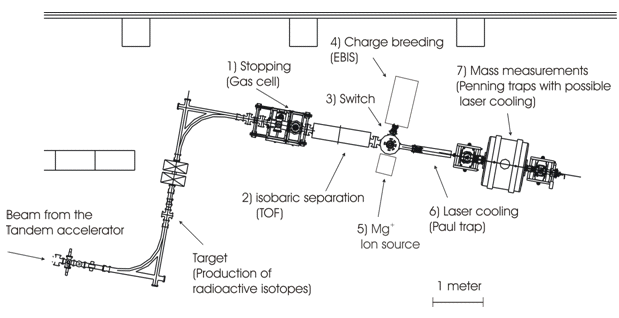Partenaires
MLL trap
The MLL double Penning trap system
The MLLTRAP is a double Penning trap facility designed to combine several novel technologies to purify, charge breed, (laser-)cool and bunch radioactive species and perform high-accuracy nuclear mass measurements as well as in-trap or trap-assisted spectroscopy studies. The aim is to reach a mass accuracy around 10-10.
Physics case
The double Penning trap system of the MLLTRAP setup will be used in high-accuracy mass measurements by applying the Time-of-Flight technique, while also allowing for either in-trap spectroscopic studies of carrier-free sources or trap-assisted (decay-)spectroscopy behind the trap system.
With its envisaged high mass accuracy of 10-10 MLLTRAP will be able to contribute, among other things, to tests of QED and fundamental CPT symmetry.
![]() Highly accurate nuclear mass data on superallowed
Highly accurate nuclear mass data on superallowed ![]() decays grant access to a precise determination of the Vud matrix element of the CKM quark mixing matrix, thus allowing for a stringent test of the unitarity of the CKM matrix.
decays grant access to a precise determination of the Vud matrix element of the CKM quark mixing matrix, thus allowing for a stringent test of the unitarity of the CKM matrix.
![]() A possibility for improving the accuracy of the fine structure constant
A possibility for improving the accuracy of the fine structure constant ![]() is given by determining the molar Planck constant NA*h, combining a mass difference measurement between highly-charged nuclides differing by one neutron in the MLLTRAP with wavelength measurements of corresponding capture
is given by determining the molar Planck constant NA*h, combining a mass difference measurement between highly-charged nuclides differing by one neutron in the MLLTRAP with wavelength measurements of corresponding capture ![]() -rays, which can be performed e.g. at the GAMS facility at the ILL reactor (Grenoble).
-rays, which can be performed e.g. at the GAMS facility at the ILL reactor (Grenoble).
![]() In-trap
In-trap ![]() , and conversion electron spectroscopy in the Penning trap will allow to exploit the unique properties of the carrier-free stored ions for high-resolution spectroscopy, e.g. studying E0 decays that provide access to nuclear structure information (e.g. on shape coexistence) .
, and conversion electron spectroscopy in the Penning trap will allow to exploit the unique properties of the carrier-free stored ions for high-resolution spectroscopy, e.g. studying E0 decays that provide access to nuclear structure information (e.g. on shape coexistence) .
![]() trap-assisted spectroscopy behind the Penning trap allows for
trap-assisted spectroscopy behind the Penning trap allows for ![]() decay studies in isomerically pure radioactive species
decay studies in isomerically pure radioactive species
![]() especially in view of the envisaged coupling of DESIR to S3 transuranium isotopes can be addressed, either aiming at direct mass measurements or targeting spectroscopy of ‘shake-off electrons’ from heavy nuclei, aiming at the measurement of lifetimes of excited 2+ states and quadrupole moments of transuranium elements.
especially in view of the envisaged coupling of DESIR to S3 transuranium isotopes can be addressed, either aiming at direct mass measurements or targeting spectroscopy of ‘shake-off electrons’ from heavy nuclei, aiming at the measurement of lifetimes of excited 2+ states and quadrupole moments of transuranium elements.
The planned nuclear structure studies of heavy elements can also contribute to the understanding of heavy-element nucleosynthesis and astrophysically relevant questions like the termination of the r-process by Coulomb instabilities.

Description of setup
The Penning trap system consists of two cylindrical traps and is placed in a single 7.0 T superconducting magnet with two homogeneous field regions (1 cm3 each). The actively screened magnet has a 160 mm diameter warm bore. The two homogeneous field regions are located at a distance of 10 cm to both sides of the magnet center. In these regions, where the trap centers are placed, the homogeneity could be adjusted to below 0.3 ppm, thus allowing to use both traps as precision measurement traps in order to reduce systematic uncertainties.

The first trap is equipped with a gas feeding tube allowing for isobaric purification using the standard procedure of buffer-gas cooling, however, the envisaged mass accuracy of 10-10 can only be reached when using highly-charged ions (HCI). In this case isobaric purification of the radioactive species from SPIRAL II via buffer-gas cooling in the first trap cannot be performed. Therefore the isobaric selection will be performed outside the Penning traps using first an A-selective quadrupole mass spectrometer (QMS) followed by a multi-reflection TOF mass spectrometer (MR-TOF-MS), based on the design by the Giessen group. Prototype tests indicate that a mass resolving power of 105 can be reached with approximately 102 turns with a transmission efficiency of about 50%.
 Figure 3: Multi-reflection time-of-flight spectrometer
Figure 3: Multi-reflection time-of-flight spectrometer
Subsequently the isobarically purified ions will be injected via an electrostatic multi-passage spectrometer (MPS) into an electron beam ion source (EBIS), where they will be charge-bred and extracted to the MPS, acting as (q/A) separator. Moreover, the MPS allows to further transport the ions towards the Penning trap as well as to attach a Mg+ ion source, which is needed for the ion cooling in front of the Penning traps. Cooling will be done by using sympathetic laser-cooling in a linear Paul trap that serves also as a buncher. The sympathetic cooling of the ions to the mK region will be applied by laser-cooled 24Mg+ ions that cool HCIs sympathetically in a strongly-coupled one-component plasma.
Possible key experiment
![]() unitarity of CKM-matrix: high-accuracy mass measurement with
unitarity of CKM-matrix: high-accuracy mass measurement with ![]() m/m = 10-10 in e.g. 50Mn, 54Co
m/m = 10-10 in e.g. 50Mn, 54Co
![]() in-trap coincident electron+
in-trap coincident electron+![]() spectroscopy in heavy nuclei (Z≥82)
spectroscopy in heavy nuclei (Z≥82)
![]() mass measurements in Z>102
mass measurements in Z>102
Contact: Peter Thirolf, Muinch